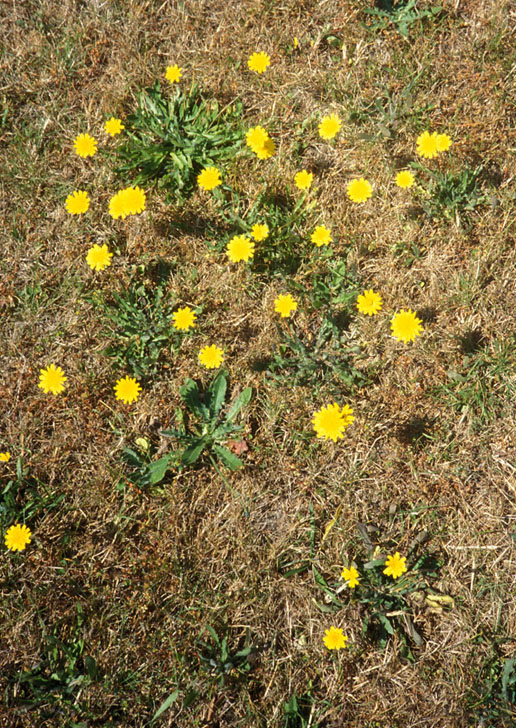
|
| Hairy Hawkbit; Leontodon saxatilis Lam. |
| = Leontodon nudicaulis (L.) Mérat misapplied |
| = Leontodon taraxacoides (Vill.) Mérat |
Sunflower Family; COMPOSITÆ (ASTERACEÆ)
|
| Have you ever noticed how certain weeds, at least in full bloom and
en masse, such as seen along roadsides or in meadows, can appear like glorious daubs of paint on the landscape of greenery? Think of bright yellow Scotch broom in May, of white daisies in June,
of goldenrod in July. Of course many others exist, not to mention wildflowers. Well, autumn's swan song of the weed world blossoms belongs to the little known Hawkbit, Leontodon saxatilis. (Speaking of swan songs, this is our last weed column, since we've
done 100 species.) |
| Hawkbits are little known because, like many of their associates, they bear yellow, dandelion-like flowers. And, to
casual observers, about a dozen distinct species of weeds may be called "dandelion" simply by virtue of their similar yellow
flowers. Anyway, the hawkbits especially stand out in late summer and fall, long after the April blooming heyday of the original dandelion. |
| Only one species of Hawkbit grows in Seattle. The scientific name
Leontodon is from Greek leon, a lion, and odous, a tooth. Hence lion's tooth, just like the French name dent de lion which evolved or corrupted (take your pick) into the English dandelion. The name Hawkbit perhaps has a logical, or at any rate an interesting explanation, but I've not yet ferreted it out. It is ripe for
confusing with Hawk's-beard and Hawkweed. |
Maybe this list will help. Following are yellow-flowered members of the sunflower family
(compositæ) which grow weedily in Seattle, and their weed column dates.
|
| Crepis capillaris Hawk's-beard (August 1994) |
| Hypochæris radicata Cat's-Ear (December 1987) |
| Lactuca serriola Prickly Lettuce (April 1988) |
| Lapsana communis Nipplewort (November 1991) |
| Leontodon saxatilis Hairy Hawkbit (August 1995) |
| Sonchus arvensis Creeping Sow-thistle (May 1992) |
| Sonchus asper Prickly Sow-thistle (May 1992) |
| Sonchus oleraceus Common Sow-thistle (May 1992) |
| Taraxacum lævigatum Redseed Dandelion (April 1987) |
| Taraxacum officinale Common Dandelion (April 1987) |
Tragopogon pratensis Yellow Salsify (June 1994)
|
Hawkbit species are comparatively unimportant weeds, and are easily told apart (once they are recognized as not
dandelions). Hairy Hawkbit (L. saxatilis) is grown at Tilth's weed bed. In the wild it is usually less than 6 inches tall; in cultivation
it responds by reaching up to 15 inches. Its leaves are less bitter than those of dandelion, and if you don't mind their hairiness, are
okay to eat. Each flowerhead is 3/4 to 11/8 inches wide. A whole meadow of them flourishes in Seattle's arboretum, between Boyer
Avenue and Azalea Way. Go rejoice in the beauty. Fare well you weed-readers.
|
Originally published as the Seattle Tilth newsletter Weed of the Month in August 1995, along with an illustration from a book.
Back |

